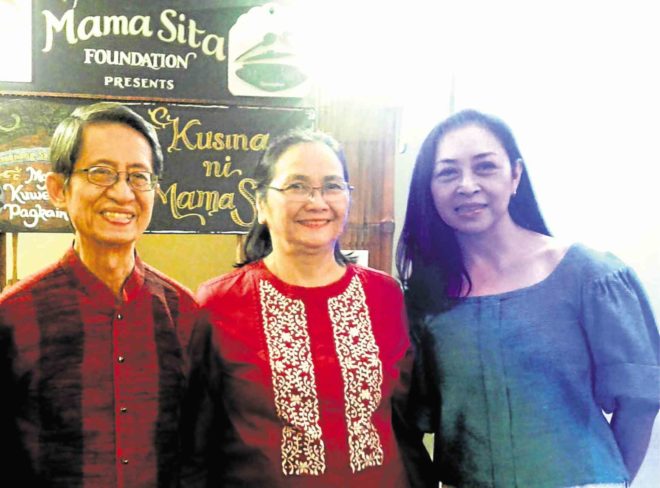
Ilocano strong.” I remembered his pronouncement when I had to write about Ilocano cooking for the first time. And then, of course, papa’s stories about getting the munamon (dilis or anchovy) from the Bicol Express, which landed at San Fernando, La Union, then to processing those in his Bauang hometown by salting—then stomping on the mix!
He chuckled as well at my reaction of surprise and dismay. But yes, he said, it was just like how winemakers of old processed grapes into wine.
Two entries
The Doreen Gamboa Fernandez (DGF) Food Writing Award awaits your bagoong stories. To give you more time to submit, the award body has extended the deadline to Nov. 30. The essay entries should have 800 words and should include research on the subject.
Put a pen name on the essay. Submit by email to [email protected], including another file that lists your pen name, real name, title of the essay, address and contact details. Each contestant can submit two entries. Cash and book prizes await the winners, as well as inclusion in a book of winning DGF essays.
Ilocos was the focus of an invitation from the Ateneo de Manila Cultural Heritage Studies to a dinner at Victorino’s Restaurant in Quezon City, which specializes in Ilocos cuisine. But it turned out there was much more to talk about than the food. We were to hear a report from both faculty and students about issues of food security and nutrition, root crops, the abel (woven cotton cloth) and the significance of the binakul (optical art) design, and the disappearing craft of traditional tambourine jewelry.
One of the dinner sponsors was Mama Sita, a food company named after Teresita Reyes whose daughter, Clara Lapus, carries on her mother’s mission to tell the world about Filipino cooking, ingredients and heritage.
Mama Sita products not only include convenience mixes like sinigang as well as sauces, real vinegar, heritage rice varieties like the red Kalinga Jekot and the black Balatinaw. Mama Sita has also announced the opening of a contest on regional food stories, “Mga Kwentong Pagkain.” Deadline for submission of entries is Jan. 26, 2018.
Vegetables and root crops
Fernando Zialcita, who heads Ateneo’s Cultural Heritage Studies, welcomed guests and pointed out how Ilocanos are known for their dietary preference for vegetables and root crops. Root crops seem to be a favorite subject of Zialcita, who expounded on the topic in another dinner a year back and who, that evening, told the story of how the white potato was introduced to Europe from Mexico via Peru and Bolivia.
My seatmate that evening was a Mexican anthropologist, Amalia Ramirez Garayzar, who is here to study Filipino weaving. She told me that root crops were also regarded as lowly crops in her country, eaten only by poor and barrio people. She was surprised that the young leaves of kamote (sweet potato) can be eaten, as she saw in the menu.
Kamote tops were, indeed, on the buffet table, with a vinaigrette flavored with bagoong and with chopped red tomatoes providing the color contrast to the green leaves. Supervising the feast was Heny Sison, a partner in the restaurant who is also known for her cakes and pastries, and culinary school.
She read a message from restaurant owner DV Savellano, governor of Ilocos Sur, who was taken ill and couldn’t attend the event.
Kamote dominated the offerings. Soup was a creamy mash of sweet potato, and the lumpia (spring roll) had kamote and shrimp. The roast beef was accompanied by kamote and tomato, the combination called kamotato. The sweet endings were kinalti (kamote sliced thinly and cooked in panutsa or jaggery) and a rice cake called patupat served with mango balls.

Familiar dishes
Familiar Ilocano dishes served included the pakbet, which had the expected bitter ampalaya (bitter melon).
The dish was a recipe of the Savellano family. Rice was both plain and an Ilocano fried rice called kinirog that contained dried fish and bagoong. Instead of chunks of bagnet (deep-fried pork), the pieces were sliced like bacon and were called chips— something new, but not my preference.
Mama Sita offered samalamig, cooling drinks of gelatin and syrup of pandan or muscovado. Coffee was served with balikutsa, Ilocos pulled sugar shaped like the top of Greek columns.
After nourishing the body, it was time to stimulate the mind as the talks began.
From what I gathered, Ilocanos utilize a variety of vegetables, beans and root crops that are cheap, easy to grow, and filling. I am also heartened that local weaving is being preserved, and learned that the binakul op-art design had a healing purpose—the evil spirits would supposedly go cross-eyed looking at it. Young students were in awe of the patterns, wondering how the ancient weavers programmed their brains to know exactly how to do the binakul.
They also learned, to their alarm, that the filigree art of tambourine jewelry risks being lost. Very few artisans now do them since they can’t sell enough or attract new buyers, who regard the tambourine as old-fashioned.
How exhilarating to eat and learn. Some of us lingered, treated by Heny Sison to her tall cakes of sans rival, chocolate torte and cheese cake and good black coffee while we discussed more Ilocano cooking, and how we wished we could go Norte and Sur again not just for the food, but also for the arts and crafts.









































